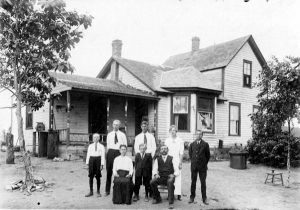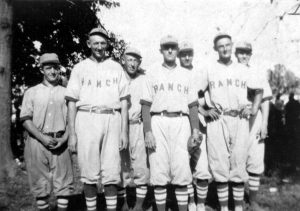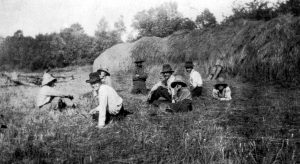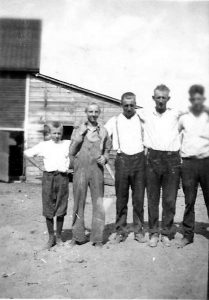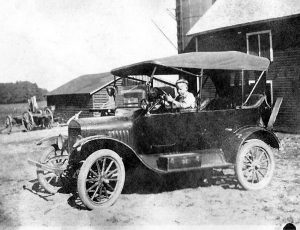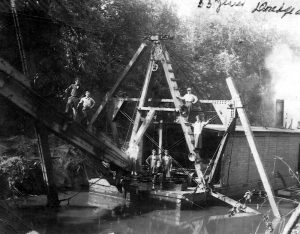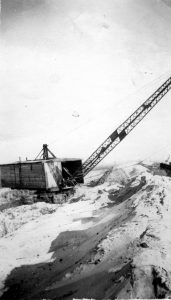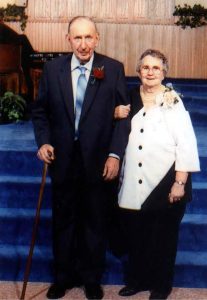Leonard (Buzz) Swart
The Settling of the Grand Marsh of the Kankakee River
Interview by Laverne Terpstra, Transcribed by Shirley Zeck
November 14 1994
I was born about one and a half miles south of here, on the Kenny DeVries Blueberry Farm in 1908. I just had a birthday. I am 86.
I don’t know why my grandparents moved to this area. My grandparents on my mother’s side owned 80 acres of ground where Kenny DeVries Blueberries is and the Sytsma’s place is (14241 N 700 W). When they died it was divided up between three children, my mother, Mrs. Mak and Tom Abbring. My mother and Mrs. Mak got the 80 acres and paid Tom Abbring off. My mother’s name was Anna.
I always had to get wood in, split wood for the cookstove and also haul in wood for the stove in the winter time. We burned wood just about all summer long in the cookstove. That how my mother cooked. It was all in the house. We finally got a little kerosene stove. We used that in the real hot weather. Most of it was all baking and everything on the cookstove.
I went to school at Tyler School. It was down the road here where Kaper’s Subdivision is (700 W Castilian Dr.). When I was in the third grade we moved to DeMotte School. I had to walk about a mile and a quarter to Tyler School. In bad weather and if it was raining too hard they would take you in the horse and buggy.
When they first built the DeMotte School in 1914 everybody was going to move to DeMotte School. But they soon found out when they brought all the country kids in they didn’t have room for them all. So, the closest ones around DeMotte went to the DeMotte School and the country kids went back out to their country school again.
I think it was in 1916 they put an addition on the DeMotte School and then everybody went to DeMotte School. They moved us out of the Tyler School with a team and wagon and took us to the school. Back then they had horse-drawn school buses. They could hold 12 or 15 students. In the winter time they had a little stove underneath the school bus. Sometimes they would have to stop along the road and fire up the stove a little more to keep the school bus warm. They used sticks of wood. When I was sixteen years old, I quit high school and stayed home to work. Most people did at that time.
My father farmed a little, bit but he did a lot work for the Northern Indiana Land Company. He kept buildings in repair for them. He had a steady job with Mr. Enz who looked after Northern Indiana Land Company. He was located where Rob Schoonveld now lives (7390 W 1400 N). There was a big house there and it burned down when a tenant lived there.
The Enz family lived there, and he had an office in the house. He was the overseer for the Northern Indiana Land Company. He did all the hiring of the help who did all the improvements, building new buildings and everything. The area this covered was north of Wheatfield on SR 49 out west to the county line. It went from the river to where Evans Farm now is (13861 N 700 W). That was the old Ranch Headquarters. That was about the south end of it. That was where all the hired men stayed and people who lived there cooked the meals for them.
My brother Neal worked for Mr. Enz for a couple of years. He made $60 a month plus board. That was good wages the. He fed cattle and did farm work. He would be busy all the time in the winter feed cattle.
The old house where Sytsma lived (our place) was the last house until you got about a mile north of the river. There were no houses out here. This old Hebron Grade (700 W North of 1700N) was a dirt road back in those days and pretty muddy too.
That was the main road. SR 231 was not there then.
My mother used to tell me when she was a girl if they wanted to go to Hebron, they had to go clear up around Baum’s Bridge in order to cross the river, the marsh and come back to Hebron again. It was an all-day event with horses and wagons.
One Saturday afternoon there was a show troupe from Kankakee, Illinois that usually made the rounds going east across northern Indiana and come back again. They would make all the small towns, usually two-night stands, Friday and Saturday nights.
Anyway, that was back when the saloons were going. One of the players in the saloon on Saturday afternoon made a wisecrack about some of the DeMotte girls. It didn’t set very good with this fellow. He hit him over the head with a beer bottle and killed him.
Passenger trains were going through DeMotte at that time (four passenger trains a day). There was one in the evening (four o’clock) going west to Kankakee. Since he was from there they loaded him in a baggage car and took him to Kankakee. They gave a choice to the fellow that killed him to either stand trial for murder or go into the Army. That was during WWI. So he took the Army and that was the end of it. That was a lot of excitement for DeMotte.
One of Konovsky’s buildings was where the tavern is now (804 S. Halleck). There was a garage building in the bottom and space up above. It was a place where they had shows. They had moving pictures there sometimes. The Gordon players always played up there to big crowds.
There were always baseball games on Sundays. They played wherever they could make a ball diamond. Back in those days every wide spot in the road had a ball team.
They also had barn dances usually every Saturday night someplace. The place where Enz’s lived had a big barn (it is still standing) where they had barn dances. There would be up in the hundreds of people attending. They would come from all of northern Jasper County. They were held every Saturday night. The newspaper was the Kankakee Valley News or something like that. It was printed out of Rensselaer. It had Wheatfield news. Maybe at one time it was printed at Wheatfield.
Wheatfield used to be quite a going town, a lot bigger than DeMotte. They had shows going every Saturday and Sunday night in Wheatfield.
At that time it had grocery stores, drugstores, meat markets etc. The train also stopped in Wheatfield.
The trains hauled everything, even livestock. There used to be stockyard pens in DeMotte west of the elevator (800 S. Halleck). They shipped out cattle. If somebody had a lot of cattle to sell, they would drive them to the pens and load them in cattle cars. They would go to Chicago to the stockyards.
My dad and older brothers made a lot of wild hay. The first bales that they made were made by horse power. A team of horses would go around in a circle. They made the power for running the hay press.
Later on they bought a big gasoline engine that ran the press. They would ship out a lot of wild hay in boxcars. There was a switch on the old Gifford track where Harry Postma lives (13700 N 700 W). They would load the bales in cars there and ship it to Chicago. That was what they did mostly all summer long. It was sold to hay brokers in Chicago.
They would bale hay in all area. I was too young to bale but my job was to bring dinner out to them at noon. I would walk out with a couple of milk pails full of sandwiches and coffee. My mother would fix it.
My dad always fed the hay press. My oldest brother Tom and another fellow that worked for my dad would pick the hay up on the hay press. My other brother Neal would take care of the bales, piling them and feeding wires in the hay press. Another brother Louie would run the bull rake and bring up hay all the time to the hay press. Brother Ben would run the rake on the ground. It was my job all the time to take them their dinner when they were working. Of course, it had to be dry weather in order to make hay.
They cut hay with mowing machines and horses. My dad got a tractor made out of a Model T Ford. He used that on the front end of the mowing machine. One thing about that, the horse flies didn’t eat it up like it did the horses.
My dad bought the tractor outfit that was manufactured to make a tractor out of a Model T Ford. The wheels were taken off the back end of the Model T and they put on big steel wheels in front of where the Model T wheels went.
Dad and my older brothers always did a lot of trapping in the winter time. They would catch a lot of muskrats and mink, coon and possum. Whenever they would have two or three big burlap sacks full of hides they would take them to Chicago to the big fur dealers and sell them. They would take them in the Model T Ford. It was an all-day event. After WWI hides were real high.
One time my brother Ben and I (I guess I was only about 9 or 10 years old and he was three years older than me) set a bunch of traps on Friday night after school. Of course we had to look after them on Saturday morning. We had a big mink in one place. Dad’s hound dog went with us. While we were killing one mink he was out hunting and got another mink. Two kids were about ready to bust the buttons off their shirt when they went home with two big mink. My dad kept them separate when he sold them in Chicago. They got $22.00 a piece for them. They were all sold to big fur houses in Chicago. Taylor and Fulton were two of the big fur houses. They bought all the raw furs, and of course the finishers who made coats bought from them.
We had to skin, stretch, and dry the furs. They didn’t want to buy green furs. At one time back before the river was drained, my dad and another fellow were trapping together all winter. They even had a tent set up in a place. When they came home they would start a little fire in the stove, in the tent and do all the skin stretching in there.
Groundhogs would dig dens, and fur-bearing animals would take over the dens in the wintertime. That’s where they would hole up at and set their traps by the holes. If you were lucky enough, you caught something. You didn’t know what you were going to catch.
I saw the dredge that dug the Kankakee River out on the Old Grade. My dad heard in town that it was going to be up close by the Grade. We got in the Model T and went out to see it. It was a big outfit. It wasn’t done in one year.
They did it all in one operation as wide as it is now. They dug here from Baum’s Bridge from the State Line. They would dig up a ways on one side and throw all the bank up there. They’d throw back and take half of it and throw it on the other side.
When they got up here it was small enough that it was supposed to be. They could reach by staying in the middle and throw all the dirt both ways.
I don’t know where it came from, but it was a big outfit. It floated right in the water. One man was usually the main operator when it was going. But there were probably half a dozen guys working on it to keep it going.
There were firemen and blacksmith and everything right on the dredge. So if anything broke they could fix it right there.
My brother Neal worked on what they call the brown Ditch. It starts up here at Kahler’s Bridge east up here, and it runs to the bridge where Tom Postma lives (14621 N 700 W). A guy from Hebron State Senator Bill Brown owned that. My brother Neal worked on that all the time. There were four that ran that dredge.
I didn’t see them build either one of the bridges, but I worked on the road when they paved US 231 from a gravel road. They dug ditches on both sides and threw the dirt up the middle in order to make the grade. Then they flattened it down and graveled it. It was done mostly with horses.
Later on, around 1928 they made a paved road out of it.
The first year we were married, we were down to my mother’s little place. I rented quite a little ground around the country all that I could. I farmed with four head of horses. The next year I moved to town on Konovsky’s place west of town. I was driving the school bus, too and doing farm at all small places around besides Konovsky’s farm. I heard that this place out here was going to be for rent. The overseers name was Nolton from Freeport, Illinois. They had a big mortgage on all this Land Company ground, and they foreclosed on Northern Indiana Land Company. That’s how they got control of it.
The result was after they got foreclosure proceedings all done they started selling it out. We moved out here in 1936 (6670 W 1600 N). There was only about 35 acres of farm ground on this whole place here. Then there was a quarter section over in Wheatfield township that they owned too. I farmed that. The township line is on the east side of this place.
We cleared a lot of ground. There were a lot of trees. A big fire went through here about 1928. There was much vegetation on the ground. It made such a hot fire it killed the green trees and burned the tops right out them. It killed all but the elm trees. You usually had to dynamite them out and break them up some so you could pull them out with a tractor.
There were a lot of trees to haul out for firewood. Everybody could get as much firewood as they wanted. Besides that, there was an outfit from Gary that was making baker’s wood. They used it in the bakeries to bake with. It was two-foot-long and about 2 and one half inches square pieces of wood. There were wood splitters back in those days that split it. Then they would haul it in to Gary. It was a booming city then, not like it is today.
After the best of it was gone you usually had to pay about $4.00 an acre for it. But you could haul 25 to 30 wagonloads off an acre of ground. The trees were so thick, you couldn’t even drive a team of horses through them without clearing them out first.
It seemed to improve the ground with all the ashes back on the ground. I let a lot of the ground out to different guys to clear just for the first crop that they got off of it. About all it was they would do was pick up the burnt stuff and pile it up and burn it. They would get the first crop for doing that.
I bought most of my farm machinery from Otto DeYoung and Sons in DeMotte, tractors, plows and corn planters. I would buy new plow shares once in a while, but we would take them to the blacksmiths and have them resharpened and reworked. They would last quite a while. Caleb Cheever ran a blacksmith shop in DeMotte before he started the garage. It was in the same building where it is now. He would even shoe horses there. He had a half-brother who was a blacksmith also.
Back then when the Northern Indiana Land company owned the ground yet International Harvester (McCormick outfit) had a lot of machinery out here. They were using the ground as test plots to test their new machinery with. The old wild hay ground was about as tough to plow as any ground was. It was sod. They had all different kinds of plows and tractors back in those days. They were just starting to make tractors. That was just about one-half mile south of here. It was like a little town set up out there where they lived in tents in the summertime.
Then the Northern Indiana Land Company through Mr. Enz as overseer started selling out all the ground they could. A lot of farmers from Illinois came over and bought ground out here. A lot of them lost it too.
After WWI prices went down and they couldn’t make payments on the farms and they went back to the company again. The cleared ground sold for $125 per acre. That was a pretty high price back in those days. There were quite a few farmers from Illinois that had maybe 160 or a couple of hundred acres paid for in Illinois. They put that as down payment on a bigger place out here. Then they wound up losing it all.
A fellow by the name of Schafer owned this place where Martin Hoffman farmed (Kenny DeVries now – 6421 W 1600 N). He lost it. My brother-in-law bought the farm where Tom Postma lives now (15841 N 700 W). They lost it. There were quite a few who lost farms. It was before Depression Days yet.
Back in Depression Days you couldn’t pay for anything. As soon as everything got built up after WWI then farm prices went way down.
The Land Company had built small houses on most of these farms. This house that used to be here I sold to a neighbor, Obenchain. Our old house (Mart Hoffmans’) was built when the Land Company had a big sawmill out here on a ridge. They sawed a lot of lumber out there.
They would build houses for the guys that worked on the sawmill to live in. They got the houses for working for them along with their pay. But after they started breaking up the ground farmers lived in the houses.
After the Kankakee River was dug all this ground through here was well-drained. The river took care of it. Back in the early 1930’s they tapped the Yellow River into the Kankakee up east here. That was bigger than the Kankakee was itself. The result was they kept tapping more ditches into the Kankakee and finally it flooded over.
Back in the 1920’s you could raise wheat any place out here without being drowned out. When we moved out here I started raising some oats and wheat along with corn. My neighbor Mart Hoffman had a threshing machine. We would exchange work, and we would get threshing done that way. A couple of neighbors would go together and have enough help to keep the outfit going. We always ate dinner wherever we were threshing. The ladies cooked it. It was a lot of work.
The bus that I was driving had a Model A Ford truck on it. It was a pretty big school bus. I got the idea that I could drive it on single wheels on the back end. I had to go around a dirt road going to Kersey to pick up kids over there. On the way coming back I noticed the track on the road was about like a snake traveled. I got to thinking, by gosh that’s my track from the school bus. So, I stopped and got out and looked and the back wheel was ready to break off the bus. I had a spare wheel and put that back on, and went to town to buy another wheel. From then on I used dual wheels. It was a big bus and had so much swing to it that it cracked all holes in the rim of the wheel. You could buy them a junkyards.
I think I had around forty kids in the school bus. It was the biggest school bus that the DeMotte School had. It was the newest. Simon Groet was trustee, and we both went to Indianapolis and got the school bus one day.
Then I got the job hauling basketball players all winter long at night time. There would be some fans in the bus, too.
Hank Boezeman drove a school bus most of his life, I think. Ben Hoffman, Gerrit Woudema, and Bert Duggins drove school buses. Dig Gleason drove for a while and also Elb Cheever.
After we moved out here I had so much work to do. You would work from eight in the forenoon to eight in the evening. We never went very many places in those days.
We had an old $20 Chevy when we were first married. I had the school bus truck also. DeMotte was about as far as we went.
We had a garden every year. We had a good strawberry patch too. One time the landlord and his wife came out here. It was wet from so much rain you couldn’t do anything in the fields so we were all busy picking strawberries. The landlord Paul Thompson and his wife came out. They came right down to the strawberry patch and started picking and eating strawberries until they got filled up.
The grocery store in town where the tavern is now, (804 S. Halleck), was run by Hank Swart. Then he sold that out to his nephew Billy Swart. It was always Swarts Store, but no relation to us.
South a little bit there was another grocery store, DeKock’s. Down at the other end there was a store started out by some of the farmers out south of town. Andrew Kamminga ran it most of the time. It went out of business and Henry DeKock had a hardware store in there. Howard Evans had a hardware store for a while.
Before that there was the McGinnis store about where DeYoung’s store was (824 S. Halleck), close to Al Ewart’s building. There were places where you could get a hamburger and a cup of coffee – restaurants. Curtins and Mary Starkey had restaurants (806 S. Halleck). Art Lageveen had a drygoods store south of Swart’s grocery store. After the town burned Art built on the east side of the street (821 S. Halleck).
There were not very many buildings on the east side. There was Bunning’s JP place. It used to be Herman Ostings shoeshop. They built on the west side and sold that building to Mr. Bunning. He was always Justice of the Peace in DeMotte. He was John, Walt and Hank’s dad. A little south of there Neal Sekema’s had a creamery shop. They finally moved that back and built a garage where the creamery was.
Roy True had a barbershop on the west side of the street where Pop Rowen had a bakery (816 S. Halleck). It was a wooden building. It was north of Ken Nannenga’s furniture store (814 s. Halleck). The hotel was on the corner on the east side.
I don’t remember when Konovsky started the saloon and lumberyard and elevator. It was long before WWI. He was a very honest man.
Most of the stores had a cement or board sidewalk, but there was a stretch from Al Ewart’s building (824 S. Halleck) to the restaurant (832 S. Halleck) where there was never any sidewalk. It was all sand sidewalk they called it.
Back in the early days, there were hitching posts where you could tie your horse when you went to town with your horse and buggy.
Transcript of Taped Interview with
Leonard (Buzz) Swart
Interviewed by
Laverne Terpstra
Transcribed by
Shirley Zeck
Sponsored by
Demotte-Kankakee Valley Rotary Club
Oral History Project



